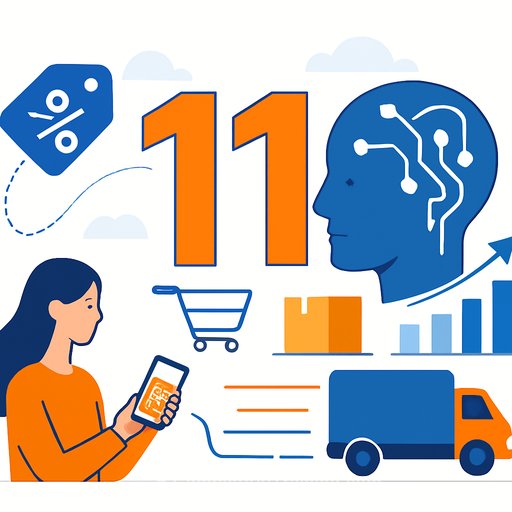Double 11, 2025: AI moves from headline to standard operating procedure
Chongqing - This year's Double 11 shows AI embedded across the entire e-commerce chain. Think less hype, more throughput: smarter coupon allocation, faster logistics, and lighter merchant workloads during peak.
The thread running through it all: measurable lift. Platforms report higher coupon redemption, tighter routing windows, and cleaner handoffs between bots and human teams.
Demand shaping with AI-directed coupons
Tmall applied AI to part of its 50 billion yuan in coupons, lifting redemption by about 15%. That's a direct lever on traffic quality and basket size without bloating subsidy spend.
Operationally, this means moving from static rules to allocation based on predicted uplift, inventory positions, and margin guardrails.
- Set hard caps: per-user frequency, per-SKU subsidy, and daily burn limits.
- Use holdouts to measure true lift vs. cannibalization.
- Feed inventory and fulfillment constraints into coupon logic to avoid stockouts and split-ship costs.
Logistics: AI models plus robots increase flow
JD integrated large AI models with its robotic fleet for the first time in core logistics. Their models calculate optimal plans within about two hours, while coordinated robots lift frontline delivery efficiency by nearly 20%.
At one site, over 800 sorting robots handle apparel orders with high precision. The signal is clear: AI planning cycles and robotic orchestration are compressing dock-to-stock and last-mile windows.
- Replan often: run routing, labor, and slotting optimization every 2-3 hours on peak days.
- Coordinate human-robot work: dynamic task assignment, congestion control, and battery-aware scheduling.
- Track the right KPIs: units per hour (UPH), on-time rate, touches per parcel, rebin/recirc rate.
Deeper behavioral models sharpen recommendations
Tmall and Taobao expanded data windows from six months to ten years and boosted compute 40-fold. Result: product recommendations became more accurate, with buying efficiency up about 25%.
For operations teams, this reduces pick variability and returns, and aligns inbound inventory with likely demand.
- Unify long-horizon data in a feature store; audit feature drift monthly.
- Share signals to ops: expected order profiles, cutoffs by region, and return probability by SKU.
- Use the same features for demand planning, promo targeting, and routing to keep decisions consistent.
Merchant operations: AI agents handle peaks
JD is giving merchants large-model tooling to manage order spikes and inquiries. With AI personas and custom voice, brands can spin up a digital human in about an hour, handle complex issues with 98% accuracy, and lift conversion by 31%.
This pulls load off human agents when it matters most, while keeping handoffs clean for edge cases.
- Wire agents to your OMS, WMS, and CRM so they can actually resolve, not just reply.
- Measure deflection rate, first contact resolution (FCR), escalation rate, and average handle time (AHT).
- Version your knowledge base; run side-by-side tests before full switch-over.
Expert view: AI as the core operating layer
Industry experts point to AI's tight integration across traffic distribution, consumer experience, and merchant ops. Platforms now ship mature tools on both sides: personalized services for consumers, plus product selection, inventory, and supply chain optimization for merchants-lowering costs and improving promo efficiency.
What operations leaders can run next quarter
- Coupon control tower: Move to uplift-based allocation with margin and inventory guards. Weekly lift studies; daily budget pacing.
- 2-hour planning loop: Recompute routes, labor rosters, and slotting every two hours on peak days. Keep deterministic fallbacks if models time out.
- Robotic coordination layer: Central assigner for pick, sort, and recharge; congestion pricing for aisles; real-time throughput dashboards.
- Long-horizon feature store: Ten-year event history where available; automatic feature drift alerts and recalibration.
- Support automation: AI agent connected to OMS/CRM with secure actions: cancel, reship, refund. Human-in-loop on high-risk flows.
- Risk and compliance: Coupon abuse detection, voice spoofing checks, model output logging, and rollback plans.
Back-of-the-envelope impact
- Coupons: Incremental GMV ≈ extra redemptions × average basket uplift × margin.
- Logistics: Labor savings ≈ UPH gain × peak hours × headcount × labor cost.
- Support: Cost-per-contact ↓ via deflection and faster resolution; monitor CSAT to protect conversion.
30/60/90-day execution checklist
- Day 0-30: Instrument KPIs; create holdouts for coupons; audit data pipelines; map robot-human workflows.
- Day 31-60: Launch 10-20% traffic to AI coupon allocator; deploy 2-hour planning on one site; stand up FAQ + order-status AI agent.
- Day 61-90: Expand allocator to 50% with stricter guardrails; roll 2-hour planning to all peak nodes; add returns and refund actions to agent with human review.
Links and further reading
Skill up your ops team
If you're standing up AI-driven planning, coupon control, or CX automation, a focused training track helps. See curated options by role here: AI courses by job.
Your membership also unlocks:






